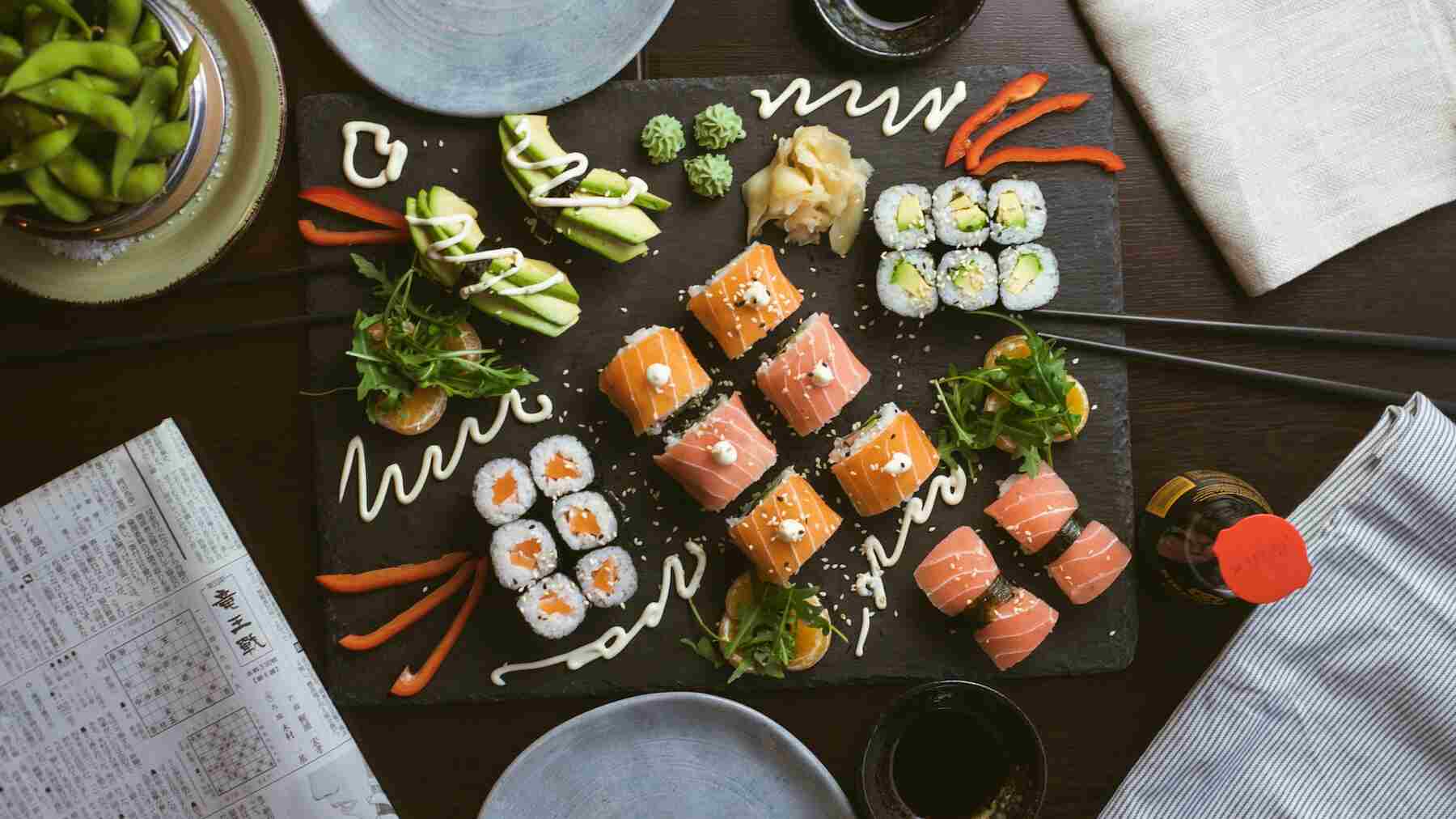Sushi: A Low Carb Option for Health Conscious Individuals

Sushi and Low-Carb Diets: Can They Coexist?
Sushi, a beloved Japanese culinary experience, presents unique flavors, textures, and colors that have captivated food enthusiasts worldwide.
However, those adhering to a low-carb diet may be concerned about the rice typically used in sushi.
This article examines sushi's nutritional facts to determine its suitability for those limiting their carb intake and provides valuable tips for ordering or creating low-carb sushi alternatives.
Navigating Sushi Options on a Low-Carb Diet
The possibility of enjoying sushi while following a low-carb diet depends on the ingredients used, as some may be high in carbohydrates.
Traditional sushi rolls containing rice and sweet sauces can be carb-rich, but numerous low-carb options exist. Examples include sashimi (raw fish without rice), nigiri (raw fish on a tiny rice bed), and keto sushi rolls made with low-carb substitutes like cucumber, avocado, or soy paper instead of rice.
Customizing your sushi order to fit a low-carb lifestyle is possible by requesting no rice or replacing high-carb ingredients with low-carb alternatives.
Identifying Main Carb Sources in Sushi
Carbohydrates in sushi primarily come from sushi rice and added sugars. Sushi rice is short-grain rice cooked with vinegar, sugar, and salt.
The vinegar preserves and flavors the rice, while the sugar enhances its taste. This combination can result in high-carb sushi rice.
Furthermore, added sugars in sweet sauces or toppings like eel sauce or teriyaki sauce may contribute to sushi's carb content.
Other potential carb sources include fillings such as avocado, sweet potato, or imitation crab meat.
Understanding Sushi's Calorie Content
Sushi's calorie content varies based on the type, ingredients, and portion size. A single sushi piece can contain 40-60 calories, while a typical sushi roll (6-8 pieces) ranges from 200-500 calories.
Higher-fat sushi, like those made with avocado or tempura batter, will have more calories than their counterparts.
Monitoring portion sizes and sushi types is essential for individuals counting calories or watching their weight.
Health Benefits of Sushi
Sushi offers numerous health benefits, making it an excellent addition to a balanced diet.
Potential advantages include nutrient richness, low-calorie content, heart disease risk reduction, improved digestion, and boosted brain function.
However, the health benefits depend on the ingredients and preparation method, and some sushi rolls with added sauces or high-carb ingredients may negate these positive effects.
To create lower-carb sushi rolls, consider choosing an appropriate rice type, using low-carb fillings, avoiding sugary sauces, reducing rice quantities, or making your sushi at home.
Reducing carbs in sushi can involve:
- Opting for sashimi.
- Choosing rolls without rice.
- Ordering hand rolls.
- Swapping white rice for brown rice.
- Being mindful of sauces.
In conclusion, sushi can be nutritious and delicious with the right ingredients.
By being mindful of rice types, fillings, and added sauces and opting for lower-carb alternatives like sashimi, hand rolls, or cauliflower rice-based sushi, you can enjoy sushi without compromising your low-carb diet.
Incorporating Low-Carb Sushi into Your Lifestyle
Adopting a low-carb lifestyle doesn't mean you have to give up your favorite sushi dishes.
By choosing wisely and making informed decisions, you can still indulge in sushi while maintaining your dietary goals.
This section will cover various low-carb sushi options, tips for dining out, and recipes to try at home.
Low-Carb Sushi Options:
Sashimi: This popular choice consists of thinly sliced raw fish without rice. Not only is it a low-carb option, but it's also high in protein and healthy fats.
Nigiri: Although nigiri features raw fish atop a small bed of rice, it generally contains less rice than a traditional sushi roll. Limiting the number of nigiri pieces consumed can help manage carb intake.
Cucumber or Avocado Rolls: Some restaurants offer sushi rolls made with cucumber or avocado instead of rice. These rolls are typically lower in carbs and provide a healthy alternative.
Hand Rolls (Temaki): These seaweed cones are filled with sushi ingredients and usually contain less rice than traditional sushi rolls, making them a lower-carb option
Brown Rice Rolls: While still containing carbs, brown rice has a lower glycemic index than white rice, meaning it won't spike your blood sugar as much.
Tips for Dining Out:
- Request no rice or a rice substitute: When ordering at a sushi restaurant, ask for no rice or a low-carb substitute like cucumber or soy paper.
- Order sashimi or nigiri: These options are lower in carbs than traditional sushi rolls since they contain less or no rice.
- Avoid sweet sauces: Sugary sauces like teriyaki or eel sauce can add significant carbs to your sushi. Opt for low-carb alternatives like gluten-free soy sauce, wasabi, or pickled ginger.
- Choose low-carb fillings: Select sushi rolls with low-carb fillings like cucumber, avocado, salmon, tuna, or shrimp.
- Limit your portions: Be mindful of how many sushi pieces you consume to keep your carb intake in check.
Low-Carb Sushi Recipes to Try at Home:
- Cauliflower Rice Sushi: Replace traditional sushi rice with cauliflower rice to create a low-carb sushi roll. Add your favorite low-carb fillings and enjoy.
- Keto Sushi Rolls: Use cucumber, avocado, or soy paper as a rice substitute, and fill your rolls with low-carb ingredients like fish, seafood, or vegetables.
- Tuna Salad Hand Rolls: Combine canned tuna with mayonnaise and seasonings, then wrap the mixture in a nori sheet with avocado, cucumber, or other low-carb fillings.
- Smoked Salmon and Cream Cheese Rolls: For a quick and easy low-carb sushi alternative, spread cream cheese on a nori sheet, add smoked salmon, and roll it up.
By exploring these low-carb sushi options, you can continue enjoying sushi while adhering to your dietary goals.
Whether dining out or experimenting with recipes at home, there are plenty of ways to satisfy your sushi cravings without compromising your low-carb lifestyle.

FAQs
Is sushi low carb?
Traditional sushi rolls made with white rice and sweet sauces can be high in carbs. However, there are low carb sushi options available, such as sashimi, nigiri, and rolls made with cucumber, avocado, or soy paper instead of rice.
What are some low-carb sushi alternatives?
Sashimi, nigiri, cucumber or avocado rolls, hand rolls (temaki), and sushi rolls made with cauliflower rice are all low-carb alternatives to traditional sushi.
How can I make sushi at home with fewer carbs?
To make low carb sushi at home, use cauliflower rice or a blend of white rice and cauliflower rice, opt for low-carb fillings, avoid sugary sauces, and consider making rice-less sushi or using alternatives like cucumber or avocado in place of rice.
Are there any health benefits to eating low carb sushi?
Low carb sushi can provide essential nutrients like omega-3 fatty acids, vitamin A, and iron. It is generally low in calories, making it suitable for those managing their weight. The omega-3 fatty acids in fish may also help reduce the risk of heart disease and improve brain function. However, the health benefits depend on the specific ingredients used and the preparation method.
What should I avoid when ordering sushi on a low carb diet?
Avoid sushi rolls with sweet sauces, white rice, and high-carb fillings like sweet potato or imitation crab meat. Instead, opt for sashimi, nigiri, or rolls made with low carb alternatives like cucumber, avocado, or soy paper.
Can I eat sushi on a keto diet?
You can eat sushi on a keto diet by choosing low-carb options like sashimi or sushi rolls made with low-carb substitutes like cucumber, avocado, or soy paper. Be mindful of the ingredients and avoid sushi with added sugars and high-carb fillings.
What are some low-carb sushi alternatives?
Sashimi, nigiri, cucumber or avocado rolls, hand rolls (temaki), and sushi rolls made with cauliflower rice are all low-carb alternatives to traditional sushi.
How can I make sushi at home with fewer carbs?
To make low-carb sushi at home, use cauliflower rice or a blend of white rice and cauliflower rice, opt for low-carb fillings, avoid sugary sauces, and consider making rice-less sushi or using alternatives like cucumber or avocado in place of rice.
Are there any health benefits to eating low-carb sushi?
Low-carb sushi can provide essential nutrients like omega-3 fatty acids, vitamin A, and iron. It is generally low in calories, making it suitable for weight management. The omega-3 fatty acids in fish also help reduce the risk of heart disease and improve brain function. However, the health benefits depend on the ingredients and preparation method.
What should I avoid when ordering sushi on a low-carb diet?
Avoid sushi rolls with sweet sauces, white rice, and high-carb fillings like sweet potato or imitation crab meat. Instead, choose sashimi, nigiri, or rolls made with low-carb alternatives like cucumber, avocado, or soy paper.
Interesting Facts
Sushi is not synonymous with raw fish; it refers to the vinegared rice that accompanies various fillings.
The first sushi rolls were made to preserve fish by wrapping it in sour, fermented rice. The rice acted as a natural preservative, storing fish for up to a year.
The California roll, a popular sushi variation with crab meat, avocado, and cucumber, was first created in Vancouver, Canada, in the 1970s.
In Japan, sushi chefs must undergo rigorous training and apprenticeships lasting up to a decade.
A giant sushi mosaic in the world was created in 2018 in Belarus, measuring 42.72 square meters and featuring over 20,000 pieces of sushi.
Related Studies
Effects of a low-carbohydrate diet on weight loss and cardiovascular risk factors in overweight adolescents.
This study investigates the effects of a low-carbohydrate diet on weight loss and cardiovascular risk factors in overweight adolescents. The results suggest that a low-carbohydrate diet may be valuable for weight loss and improving cardiovascular health in overweight adolescents. Link: https://www.ncbi.nlm.nih.gov/pubmed/18614719
Low-carbohydrate diets for overweight and obesity: a systematic review of the systematic reviews.
This study provides a systematic review of systematic reviews on low-carbohydrate diets for overweight and obesity. The review suggests that low-carbohydrate diets can lead to significant weight loss and improvements in various health markers, making them a valuable tool for managing overweight and obesity. Link: https://www.ncbi.nlm.nih.gov/pubmed/30675865
Comparison of weight loss among named diet programs in overweight and obese adults: a meta-analysis.
This study compares the weight loss effects of various named diet programs, including low-carbohydrate diets, in overweight and obese adults. The results suggest that low-carbohydrate diets are as effective as other named diet programs for weight loss. Link: https://www.ncbi.nlm.nih.gov/pubmed/25182101
Effects of a low carbohydrate diet on energy expenditure during weight loss maintenance: randomized trial.
This study investigates the effects of a low-carbohydrate diet on energy expenditure during weight loss maintenance. The results suggest that a low-carbohydrate diet may increase energy expenditure and lead to more significant weight loss maintenance than a high-carbohydrate diet. Link: https://www.ncbi.nlm.nih.gov/pubmed/23446962
Low-carbohydrate diets and all-cause mortality: a systematic review and meta-analysis of observational studies.
This study provides a systematic review and meta-analysis of observational studies on low-carbohydrate diets and all-cause mortality. The results suggest that low-carbohydrate diets are not associated with increased mortality risk compared to other diets. Link: https://www.ncbi.nlm.nih.gov/pubmed/30109779
Conclusion
As you explore low-carb sushi options, it's essential to choose high-quality ingredients that maximize flavor and nutritional value.
To ensure the best taste and quality in your sushi creations, we recommend visiting Wild Foods' website.
They offer a wide range of sustainably sourced, premium ingredients that can elevate your low-carb sushi experience.
Discover their extensive product selection, recipe ideas, and valuable tips by visiting their website at https://www.wildfoods.co/.




